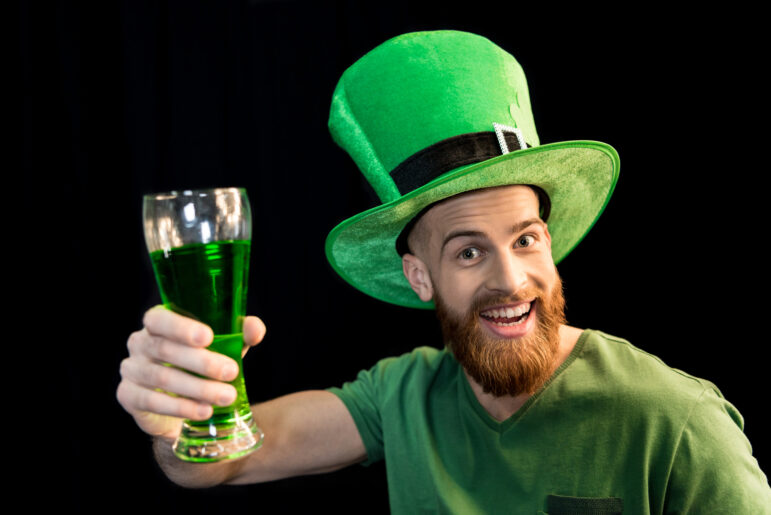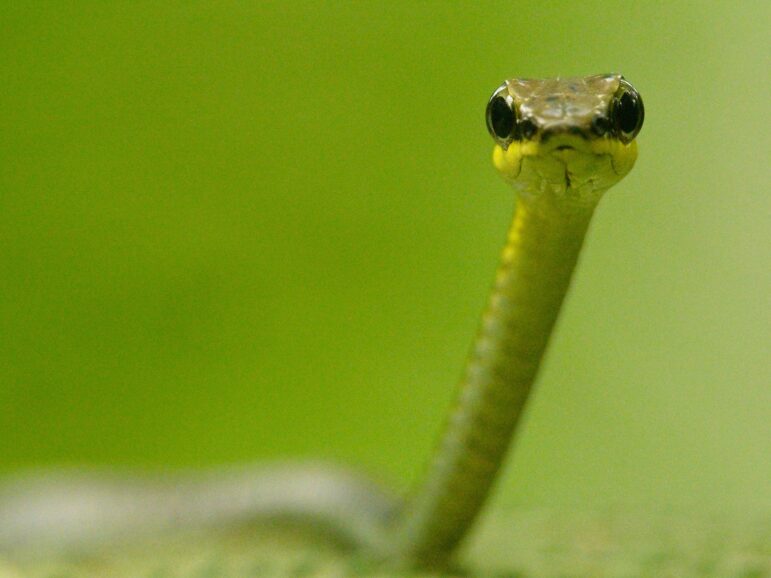
On March 17, people around the world gather to celebrate the feast day of Ireland’s Patron Saint. Like most holidays, how it is celebrated today differs radically from its origins. What began as a quiet day of religious prayer has become somewhat of a Dionysian revelry, with several easily recognizable elements: Shamrocks. Snakes. Parades. Corned Beef and Cabbage. Wearing green and drinking beer. These are just a few of the things associated with St. Patrick’s Day, most of which came much, much later than the holidays’ beginnings.
Much of what we associate with the holiday today comes not from Ireland, but the United States. Irish immigrants, expatriated mainly by the Great Famine (1845-1852), used the holiday to celebrate their Irish heritage. In a new country that often saw them as being less than human (“Irish need not apply”), communities of displaced Irish banded together and created new celebrations focusing not on the religious figure, but on the living culture.
Here we get the custom of wearing green, a color associated with the faeries and not with Patrick, whose traditional color was blue. Folklore references mischievous faeries and leprechauns tormenting and pinching unsuspecting people, the protection from which is the apotropaic act of wearing green – but it is more likely that the association with green stems from the 18th century when supporters of Irish independence adopted the color for their cause.
Growing up an American of Irish descent (and living in a California city named after Ireland’s capital), pride in our Irish heritage, especially on my mother’s side, was intense. I was often told stories involving the little people, as well as the Banshee, and I felt a certain connection to these tales. Around town, the shamrock adorned several business parks and buildings, and being one of the few red-haired boys (the only one at my school for much of my early childhood), I strongly identified with the Celtic mystique that our ancestry provided.

This is a crime against beer. [DepositPhotos]
We observed the holiday as many do today: by celebrating all things Irish. As far back as I can remember we marked the day with the wearing of green (so as to avoid getting pinched!), decorating with shamrocks, having corned beef and cabbage for dinner, and (for the adults) drinking copious amounts of beer. We also had the annual viewing of Disney’s 1959 classic, “Darby O’Gill and the Little People.” We might even go to McDonald’s and get one of the highly coveted but equally reviled Shamrock Shakes. (Disgusting, but we still wanted them.)
Like many, I just accepted that these celebrations were as ancient as the man for whom the day had been named, but I and so many others were just plain wrong. There are many folktales about Patrick that simply don’t line up with history. First, though he is considered Ireland’s Patron Saint (although St. Brigid would like a word), he wasn’t Irish, but Romano-British. It is said that when he was 16, he was kidnapped by Irish raiders and brought back to Ireland where he was enslaved. He remained captive for six years before he escaped to England where he received religious instruction and then returned to Ireland as a missionary.
He is largely credited with bringing Christianity to Ireland, but historical records show that Ireland was well into its conversion to the new religion in 432 CE when Patrick began his mission.
One of the most enduring folktales about the man is that he is credited with having banished the snakes from Ireland. Fossil records indicate that there have never been any snakes there (at least not since the last ice age), the climate being too cold and the fact that it is an island presenting natural barriers to indigenous reptile life. But perhaps inspired by this scientific revelation, a more modern folk belief has emerged: that the “snakes” that Patrick banished were actually the Druids, who sometimes bore tattoos of snakes on their arms.
With this understanding, some modern Pagans view Patrick as a genocidal figure and have accordingly introduced new elements to the evolving holiday, such as wearing black and/or the image of a serpent, sometimes referring to the holiday as “All Snakes Day.” Proponents of this idea often see St. Patrick’s Day as a celebration of religious colonialism and the suppression of Pagan traditions.

“Excuse me… Do you have time to talk about the Druids?”
I will admit that when I first heard this, I believed it to be true, but like a great deal of word of mouth, internet memes, and “common sense,” it falls apart under the slightest scrutiny. It might be fun to think that the snakes were an ancient metaphor for Druids, but that never shows up in the historical record. Whenever the Druids are mentioned, it is by name – no metaphors needed. The “snakes as metaphor for Druid” doesn’t show up until the 20th century, and even then, it’s flimsy at best.
“Quite frankly the rest of Patrick’s hagiography has him dueling Druids right and left, killing those who oppose him with callous righteousness, so why would the story suddenly get cryptic about him driving the Druids out? Every other page was proclaiming it proudly! No, this particular tidbit – which is suspiciously exactly the same as a story from the life of a French saint – was always meant to be literal. The earliest reference I have found to anyone thinking the snakes meant Druids (and thanks to the friend who helped me find it) is in the Fairy Faith in Celtic Countries from 1911 where someone states that he believes based on a story that because a certain place was where the Druids last stronghold was and also the place Saint Patrick drove the snakes that the snakes must represent the Druids, but it’s just faulty logic (Evans Wentz, 1911). The snakes in the story were just meant to be snakes, just as the toads were toads and Saint George’s dragon was a dragon.”
— Morgan Daimler, “St. Patrick’s Day, snakes, and Irish-American pride”
Like Daimler mentions in their article (linked above), I am a fan of religious and secular evolution and have been excited by some of the new innovations that are being brought into the holiday. I am all for new celebrations and new symbols, but not so much a fan of bad history. By all means, we can consider snakes to be a modern symbol of Druids, but please refrain from proliferating those horrible anti-historical memes declaring this as an ancient Druidic metaphor & symbol or labeling Patrick as having orchestrated a Pagan genocide.
And as for judging others for enjoying the holiday they way they want? Just stahp. There are plenty of legitimate issues we can take with the Catholic Church, but this isn’t one of them. Maybe we could get away with that in the 90’s but I’d like to think we can do better now.
So, celebrate (or not) the way you want to celebrate. (And please, let others do the same.) Don’t want to call it “St. Patrick’s Day?” That’s great! Call it “Irish Heritage Day,” or “World Irish Day,” or “All Snakes Day,” or whatever else tickles your metaphorical leprechaun. We’re all on our own journey to the end of the rainbow to find the pot of gold there.
The Wild Hunt is not responsible for links to external content.
To join a conversation on this post:
Visit our The Wild Hunt subreddit! Point your favorite browser to https://www.reddit.com/r/The_Wild_Hunt_News/, then click “JOIN”. Make sure to click the bell, too, to be notified of new articles posted to our subreddit.